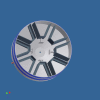Assessing spatial learning and memory in rodents
- PMID: 25225309
- PMCID: PMC4240437
- DOI: 10.1093/ilar/ilu013
Assessing spatial learning and memory in rodents
Abstract
Maneuvering safely through the environment is central to survival of almost all species. The ability to do this depends on learning and remembering locations. This capacity is encoded in the brain by two systems: one using cues outside the organism (distal cues), allocentric navigation, and one using self-movement, internal cues and nearby proximal cues, egocentric navigation. Allocentric navigation involves the hippocampus, entorhinal cortex, and surrounding structures; in humans this system encodes allocentric, semantic, and episodic memory. This form of memory is assessed in laboratory animals in many ways, but the dominant form of assessment is the Morris water maze (MWM). Egocentric navigation involves the dorsal striatum and connected structures; in humans this system encodes routes and integrated paths and, when overlearned, becomes procedural memory. In this article, several allocentric assessment methods for rodents are reviewed and compared with the MWM. MWM advantages (little training required, no food deprivation, ease of testing, rapid and reliable learning, insensitivity to differences in body weight and appetite, absence of nonperformers, control methods for proximal cue learning, and performance effects) and disadvantages (concern about stress, perhaps not as sensitive for working memory) are discussed. Evidence-based design improvements and testing methods are reviewed for both rats and mice. Experimental factors that apply generally to spatial navigation and to MWM specifically are considered. It is concluded that, on balance, the MWM has more advantages than disadvantages and compares favorably with other allocentric navigation tasks.
© The Author 2014. Published by Oxford University Press on behalf of the Institute for Laboratory Animal Research. All rights reserved. For permissions, please e-mail: journals.permissions@oup.com.
Figures






References
-
- Alamed J, Wilcock DM, Diamond DM, Gordon MN, Morgan D. Two-day radial-arm water maze learning and memory task; robust resolution of amyloid-related memory deficits in transgenic mice. Nat Protoc. 2006;1:1671–1679. - PubMed
-
- Anisman H, Merali Z. Rodent models of depression: learned helplessness induced in mice. Curr Protoc Neurosci. 2001;Chapter 8(Unit 8) 10C. - PubMed
-
- Armario A, Jolin T. Effects of water restriction on circadian rhythms of corticosterone, growth hormone and thyroid stimulating hormone in adult male rats. Physiol Behav. 1986;38:327–330. - PubMed
-
- Baldi E, Efoudebe M, Lorenzini CA, Bucherelli C. Spatial navigation in the Morris water maze: working and long lasting reference memories. Neurosci Lett. 2005;378:176–180. - PubMed
-
- Bannerman DM, Good MA, Butcher SP, Ramsay M, Morris RGM. Distinct components of spatial learning revealed by prior training and NMDA receptor blockade. Nature. 1995;378:182–186. - PubMed
Publication types
MeSH terms
Grants and funding
LinkOut - more resources
Full Text Sources
Other Literature Sources
Medical

